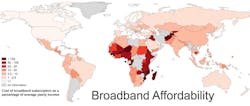Tech Challenge Seeks New Solutions for Affordable, Universal Internet Access
This article appeared in Electronic Design and has been published here with permission.
What you’ll learn:
- The IEEE's "Connecting the Unconnected Challenge" is inviting technical innovators to propose solutions to the problems that are currently denying internet access to many of the world's citizens.
- How affordable internet access can play a key role in providing over one-quarter of the world's population with better education, economic possibilities, and healthcare.
- The event will provide opportunities for its winners to commercialize their proposed solutions.
The IEEE 2023 IEEE Connecting the Unconnected Challenge invites technical innovators of all disciplines to propose solutions to the problems that are currently denying internet access to 2.9 billion of the world's citizens. These unconnected populations lack access to online marketplaces to sell goods and services, while unconnected students are denied potentially life-changing educational resources.
Startups, grassroots organizations, universities, and others working toward digital inclusion in original ways are encouraged to participate.
Organized by the IEEE Future Networks Initiative and other partners, the competition is looking for applications from early-stage projects that offer unique ways to increase broadband access and usage for unconnected or under-connected populations/geographies.
The competition's organizers, and its sponsors, believe that, in addition to helping uplift large communities of digitally dispossessed persons, increasing connectivity can also expand the global marketplace at the same time. In fact, in addition to providing unconnected populations opportunities for health, education, and economic progress, research shows that for each additional 10% of internet penetration, 1.2% is added to the per-capita GDP growth in emerging markets.
Anyone wishing to participate in the challenge is welcomed to submit an application and a 500-word abstract by July 3, 2023 at the event's registration portal.
Overview
The Challenge, now in its third year, is seeking solutions that approach the problem from one of three different perspectives:
1. Innovative Technology Applications (TA) to increase internet access or otherwise enable connectivity.
2. Innovative Business Models (BM) that result in increased affordability for internet access.
3. Innovative programs that increase Community Enablement (CE), or the likelihood that populations choose to start using the internet where previously they did not. (In this category, supply and affordability may not be a problem, but people still don’t use the internet.)
The submissions, which can be small projects or ideas that haven’t yet been tested, will be assessed based on a number of technical and societal impact criteria. These will include novelty/innovation of the idea/project and relevance to the digital divide, as well as scalability, sustainability (from a business/deployment perspective), and readiness of the proposed solution. The submissions will also be evaluated on their potential for inclusion, impact, efficacy, and risk.
Two Tracks, One Goal
The Challenge welcomes both larger, more experienced teams, and individuals or smaller, less well-resourced groups to compete in either of the Challenge's two primary tracks:
Concept-Only Track
For this challenge, the judges will look for submissions from individuals or groups who are proposing novel and innovative ideas in the TA, BM, or CE categories. Every new and innovative product, service. or program started with a brilliant idea that was sparked in someone’s mind. Do you have one of those brilliant ideas that no one has tried before?
Proof-of-Concept Track
This challenge track invites submissions from individuals or groups who have already demonstrated their innovation with a basic proof-of-concept implementation, or a pilot program, and can show preliminary results, or successful field deployment(s). The programs/projects should be early-stage in their lifecycle and can fall within TA, BM, or CE categories.
All submissions should include a description of the general design and proposed functionality, including implementation of specific features. This track is only for early-stage projects/programs, not well-established programs with a multi-year track record.
Additional details about the contest can be found at the competition's Expectations and Rules page.


